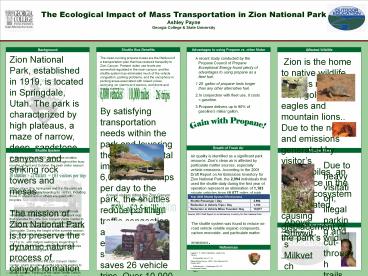48x36 Poster Template PowerPoint PPT Presentation
1 / 1
Title: 48x36 Poster Template
1
The Ecological Impact of Mass Transportation in
Zion National Park Ashley PayneGeorgia College
State University
OPTIONALLOGO HERE
Shuttle Bus Benefits
Advantages to using Propane vs. other Motor Fuels
Background
Affected Wildlife
Zion National Park, established in 1919, is
located in Springdale, Utah. The park is
characterized by high plateaus, a maze of narrow,
deep, sandstone canyons and striking rock towers
and mesas. The mission of Zion National Park is
to preserve the dynamic natural process of
canyon formation as an extraordinary example of
canyon erosion and to protect and preserve the
valuable cultural, geologic, vegetation and
wildlife resources while providing safe,
sustainable and cost-efficient access for
visitors experience and enjoyment. In addition,
the park aims to educate both visitors and the
general public about this exceptional
environment. In the early 1990s, parking along
the 6.3-mile Zion Canyon Scenic Drive was
becoming difficult for visitors. Only 400 parking
spots existed to accommodate the 5, 000 cars
touring the canyon each day. Park managers were
concerned about the resources within the park
and visitor safety and experiences of the more
than 15,000 people that tour the narrow canyon
road each busy summer day to access scenery,
hiking trails and Zion Lodge. Therefore, the best
alternative to solving the problem was
implementing a mandatory shuttle system.
The clean-running propane buses are the lifeblood
of a transportation plan that has restored
tranquility to Zion Canyon. Present visitor use
levels are somewhat regulated in the main canyon,
and the shuttle system has eliminated much of the
vehicle congestion, parking problems, and the
cacophony in parking areas associated with raised
voices, annoying car alarms and stereos, and
doors and trunks slamming.
- Zion is the home to native wildlife such as mule
deer, golden eagles and mountain lions.. Due to
the noise and emissions generated by visitors
automobiles, an imbalance in the parks ecosystem
was created, causing displacement of the parks
wildlife. - Benefits of implementing the shuttle system
- More wildlife viewings
- Less vehicle/animal accidents
- Threatened Species
- Mexican Spotted Owl
- Southwest Willow Fly-Catcher
- Desert Tortoise
- A recent study conducted by the Propane Council
of Propane Exceptional Energy found plenty of
advantages to using propane as a fleet fuel. - 25 gallon of propane lasts longer than any other
alternative fuel. - In conjunction with fleet use, it costs lt
gasoline. - Propane delivers up to 90 of gasolines miles/
gallon.
10,000 miles
6,000 vehicles
26 trips
By satisfying transportation needs within the
park and lowering the environmental impact of
over 6,000 vehicle trips per day to the park, the
shuttles reduce parking, traffic congestion and
vehicle emissions. Each shuttle departure saves
26 vehicle trips. Over 10,000 private vehicle
miles are saved every day, and an added benefit
is that the shuttles run on propane. In addition
to decreasing CO2 emissions by over twelve tons
per day, road maintenance costs are lower.
Additional benefits include the shuttles ability
to accommodate bikes, backpacks and kayaks.
Gain with Propane!
Breath of Fresh Air
Shuttle System
Affected Flora
Air quality is identified as a significant park
resource. Zions clean air is affected by
particulate matter sources, especially vehicle
emissions. According to the 2001 Draft Report on
Air Emissions Inventory for Zion National Park,
the 2,994 individuals that used the shuttle daily
during the first year of operation represent an
elimination of 1,183 private vehicles from 10,877
miles of park roads each day.
Due to heavy visitation, illegal parking and
cut-through trails, some plants are a threatened
species, such as the Shivwits Milkvetch. Since
the rise in visitation, approximately 100 exotic
species now call Zion home. While only 15 are of
major concern, the help of the shuttle system has
reduced the introduction of exotic plants.
30 shuttles
21 trailers
103 visitors per trip
Annual visitors riding the Zion Canyon Shuttle
75 of 2.5 million
Above Shivwits Milkvetch
The shuttle system was found to reduce on-road
vehicle volatile organic compounds, carbon
monoxide, and particulate matter emissions.
Contact information
References
Liggett, D. T., (2002, Fall/Winter). Quiet in the
Canyon. Sustainability news, 11-15. National
Park Service. (2007). Zion National Park Profile.
(NPS Publication No. ). Washington, DC US
Government Printing Office

